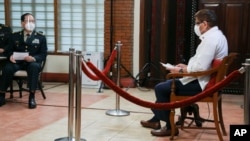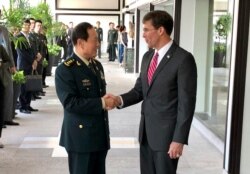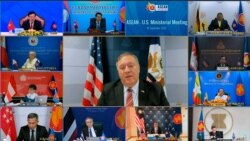The Chinese defense chief’s whirlwind tour of Southeast Asia this month will start to roll back growing U.S. influence in the region if China follows up with peaceful action, analysts believe.
Defense Minister Wei Fenghe met his regional counterparts September 7 to September 11 in Brunei, Indonesia, Malaysia and the Philippines, a Chinese government website says. His visits coincided with a series of statements by U.S. officials criticizing Beijing’s expansion in the South China Sea and U.S. commitments to protecting countries that feel slighted by China.
Southeast Asian states have claims in the same waterway and say China, backed by stronger armed forces, has trespassed. China cites historical records to support its claims.
Wei’s trip was aimed first at sustaining China’s relations around Southeast Asia, where governments may otherwise be tempted into a U.S.-led, anti-Chinese alliance, scholars say.
“The idea is to maintain stability in the region,” said Aaron Rabena, research fellow at the Asia-Pacific Pathways to Progress Foundation. “China cares a lot about that. This is especially in light of the worsening relations with the U.S. China doesn’t want a united front against them right now, so they want to deescalate tensions.”
During his meetings, Wei brought up “safeguarding the stability in the South China Sea,” China’s State Council said last week on its website.
China and the Philippines, for example, “should adhere to the principle that regional issues should be solved by the regional countries through consultation” and sustain “peace and tranquility in the South China Sea,” Wei was quoted saying on September 11 after meeting Philippine Defense Secretary Delfin Lorenzana.
“What he mainly would like to see is of course (that) Southeast Asian countries don’t fall toward the U.S. side,” said Oh Ei Sun, senior fellow with the Singapore Institute of International Affairs.
U.S. officials have increased pressure against China’s maritime activity since July. Washington lacks a claim in the 3.5 million-square-kilometer South China Sea but disputes Beijing’s argument that about 90% of the waterway is Chinese.
Chinese officials, wary of the U.S. government as a former Cold War foe, argue that Washington wants to keep Beijing’s rise in check. Trade, technology and consular problems already weigh on Sino-U.S. relations.
The Chinese maritime claim overlaps the exclusive economic zones of Brunei, Malaysia, the Philippines and Vietnam. China competes with Indonesia over a tract near the Indonesian-held Natuna Islands. The sea is prized for fisheries and energy reserves. Chinese landfilling of the sea’s tiny islets, in some cases for military use, has upset neighbors over the past decade.
U.S. Secretary of State Michael Pompeo in July called China’s claims illegal and pledged support for countries that feel impacted. In August, U.S. Defense Secretary Mark Esper said the United States would not “cede an inch” to other countries. Pompeo repeated his China stance at an Association of Southeast Asian Nations (ASEAN) event September 9.
U.S. Navy ships periodically enter the disputed sea for “freedom of navigation operations”, in turn angering Beijing.
Chinese officials must take palpable action within weeks to convince Southeast Asian governments of the defense minister’s peace message, Rabena said.
Philippine Defense Secretary Delfin Lorenzana last month accused China of fabricating its maritime claim boundary and illegally occupying Philippine waters, domestic media outlet Rappler.com reported. The sinking of a fishing boat and passage of surveillance vessels near Vietnamese waters have soured Vietnam toward China this year to date.
Wei hopes to “reassure South China Sea littoral states of China’s peaceful intention”, said Carl Thayer, Southeast Asia-specialized emeritus professor at the University of New South Wales in Australia, in a September 12 commentary.
But without follow-up, the minister’s visits come off as “too little, too late and too general and too superficial,” said Nguyen Thanh Trung, Center for International Studies director at University of Social Sciences and Humanities in Ho Chi Minh City.
“I think there is some change, but it’s just one step,” Nguyen said. “And to come up with a pattern for Chinese behavior, we have to wait for some time.”
Southeast Asian states generally avoid taking sides with either superpower, Nguyen said. They hope to accept Chinese investment as well as U.S. military support as needed.
The 10-member ASEAN bloc now wants China to wrap up years of negotiations on a code of conduct that would help prevent mishaps in the contested sea. Chinese officials have said a code should be signed by next year.


